AMD’s Lisa Su At CES: New Processors, GPUs, AI Accelerators
‘[The new AMD XDNA AI acclerator will] open up a whole new set of experiences for our users. Things like more lifelike collaboration experiences with enhanced audio and video. Think about content creation being much more productive or gaming performance being more real time. And even when you think about security, we can use AI to change the way we monitor security,’ says AMD CEO Lisa Su.
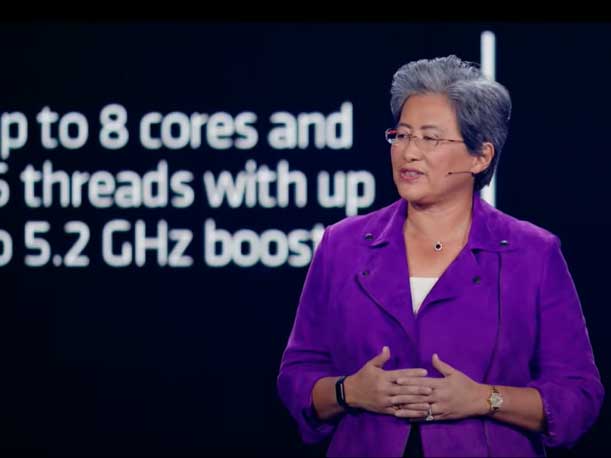
AMD’s Lisa Su Opens CES With Gaming To Data Center Advances
After a couple of years of virtual and hybrid events due to the COVID-19 pandemic, CES this week returned to Las Vegas with a fully open venue welcoming about 100,000 attendees.
Kicking off CES 2023 was AMD CEO Lisa Su who, along with such special guests as HP Inc. President and CEO Enrique Lores and Lenovo Executive Vice President and President of International Markets Matt Zielinski, showed the power of AMD’s new lineup of processors, GPUs and AI accelerators.
Su said that 2023 is an incredible time to be in the semiconductor industry given the difficulties businesses and users have faced. However, she said, the industry also had to deal with what she called an incredible surge in demand that stressed all aspects of the semiconductor supply chain.
[Related: The 10 Coolest Gadgets Revealed At CES 2023]
“One thing is true: The pandemic made it clear that semiconductors are absolutely essential to everything that we do,” she said. “Virtually every product, every service, every experience in our lives is powered by semiconductors. Whether you’re talking about cloud services, or how we work, game and connect, chips have become a critical enabler of everything in our modern life. And with the growth of AI across all of these applications, the technology is becoming even smarter and more sophisticated every single day.”
AMD, Su said, is all about pushing the envelope in high-performance and adaptive computing, and using technology to create solutions to the world’s most important challenges. And to emphasize that point, she used her CES 2023 keynote address to highlight five key areas where AMD is investing, along with some of the new technologies the semiconductor manufacturer is introducing over the next few months to meet the new requirements she identified, including:
• New AMD Ryzen 7040 series mobile processors featuring what the company calls the fastest PC processor graphics
• Ryzen AI technology to bring dedicated AI hardware to x86 processors
• AMD Ryzen 7045HX mobile processors with up to 16 Zen 4 cores
• AMD Ryzen 7000X3D processors with AMD 3-D V-Cache technology
• AMD Radeon RX 7000 laptop GPU with AMD RDNA 3 architecture
• AMD Alveo V71 AI accelerator
• AMD Instinct MI300 data center processor with integrated CPU, GPU, and HBM3 memory
Here is a closer look at these new technologies.
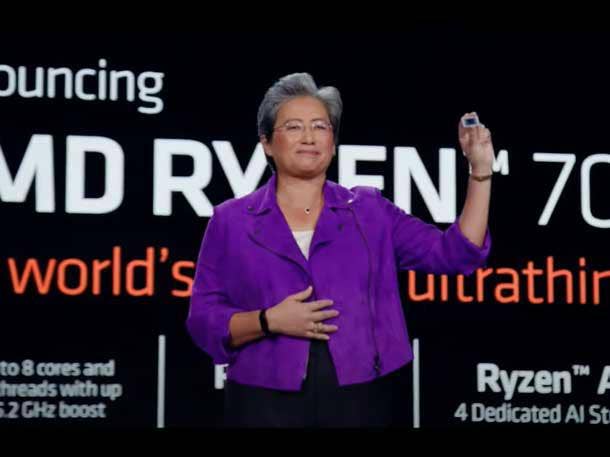
AI: The Most Important Megatrend
Su called artificial intelligence the most important megatrend for the future of technology, as it leverages the power of high-performance computing to analyze and interpret massive amounts of data to uncover patterns and make predictions on future outcomes.
AI is already being used on a daily basis, Su said. Using Siri or Alexa on a smartphone or smart device, identifying online shopping preferences, creating individualized medical treatments or even predicting weather patterns are all examples, she said.
“The full potential of AI, though, can only be realized when it is available across a range of devices from intelligent endpoints to the edge to the cloud, and to bring the right level of AI capability to all devices,” she said. “We need multiple compute engines, and that means CPUs, GPUs and adaptive accelerators. And we are one of the only companies in the world that have all of these engines.”
To meet the needs of AI, AMD introduced a new highly configurable AI accelerator, the AMD XDNA, which originated from the company’s acquisition of Xilinx early last year. Su said AMD XDNA allows AMD to scale AI from PCs to intelligent endpoints to edge devices and into the cloud in such a way that it can be configured according to application and power efficiency requirements.
“And because of this, we can deploy XDNA broadly across our entire product portfolio,” she said.
The first use of AMD XDNA will be in Ryzen mobile CPUs for notebooks, starting with the all-new Ryzen 7040 series, Su said. It is the industry’s first mobile x86 processor with an integrated, dedicated on-chip AI engine, called Ryzen AI, she said. The Ryzen 7040, built with 4-nanometer process technology, features up to eight Zen 4 cores, AMD’s latest RDNA 3 graphics, and the new Ryzen AI engine that runs four dedicated AI streams simultaneously to deliver up to 12 trillion AI operations per second, she said.
“It’ll actually open up a whole new set of experiences for our users,” she said. “Things like more lifelike collaboration experiences with enhanced audio and video. Think about content creation being much more productive or gaming performance being more real time. And even when you think about security, we can use AI to change the way we monitor security.”
Su said to expect the first Ryzen 7040-based notebooks to be available starting in March, with over 250 ultrathin gaming and commercial notebook designs spanning the entire Ryzen 7000 series portfolio on track to launch this year.
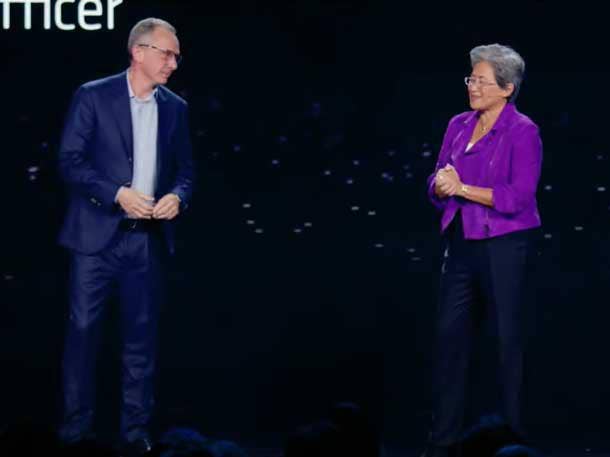
Hybrid Work Must Remain Seamless
Su said that while remote work has become commonplace, the industry has a lot to do to make hybrid work and remote work more seamless.
Su, citing a recent survey, said that over 80 percent of employees enjoy the flexibility of working from home. However, over half of those employees also said connectivity issues are actually limiting their career, and only 25 percent of people believe their organizations are really prepared for hybrid work.
“We know that technology can make this much better,” she said. “And we believe that deep co-engineering of that solution level is really required to make hybrid work frictionless for both users and IT departments.”
To show the importance of industry partnerships in addressing the work-from-home trend, Su brought on stage HP Inc.’s Lores, who said the company expects that, within the next five years, 50 percent of the U.S. workforce will be freelancers. “All these are radical changes that are opening the opportunity for disruptions for opportunities for innovation,” Lores said.
HP Wednesday addressed the hybrid work issue with the introduction of its Dragonfly Pro laptops based on the AMD Ryzen 7 processor line, which Lores said targets the freelancer community with long battery life, support at the click of a button and well-integrated communication technology.
“We have integrated in the solution the right experiences that these customers are going to be demanding,” he said.
Looking forward, Lores said AMD Ryzen 7000 technologies will be at the center of a full portfolio of HP offerings starting this spring.
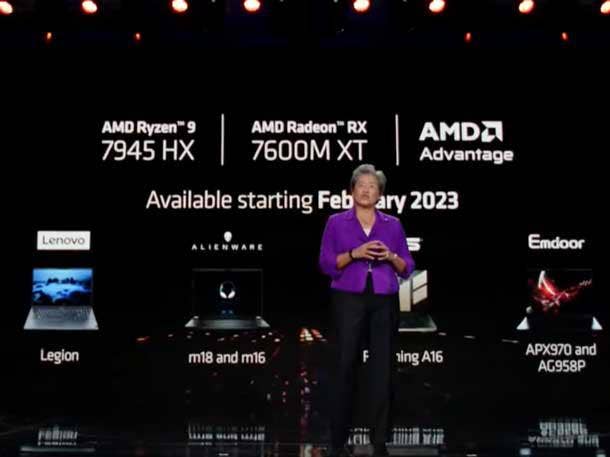
Gaming Is In AMD’s DNA
Gaming is in AMD’s DNA, making the company focused on bringing the best experience possible to the over 3 billion gamers in the world, the majority of whom play on either PCs or consoles, Su said.
AMD Ryzen processors and Radeon graphics are at the heart of gaming PCs and consoles, many of which already come with new Ryzen 7000 series CPUs and Radeon RX 7900 series GPUs, Su said. AMD, however, is targeting the growing number of gamers looking to game everywhere with new mobile and desktop products, she said.
On the mobile side, Su introduced the Ryzen 7045 CPU family. The first, the Ryzen 7045HX series, is AMD’s first mobile CPU based on a chiplet design and combines up to 16 Zen 4 cores with boost speeds up to 5.4GHz and up to 80 MB of on-chip memory.
“What we’re seeing is on average 24 percent higher performance across a range of popular games,” she said. “And when you look at content creation and productivity applications, when we compare against our competition, those 16 Zen 4 cores are delivering significantly more performance, more than 50 percent faster across a wide range of applications. That will enable creators to accomplish so much more with this notebook.”
Su also unveiled the Ryzen 7945HX, which she said increases performance for 1,080p gaming by 24 percent over the previous Ryzen 6900HX processors, as well as by over 50 percent over competitors’ processors for content creation and productivity applications.
AMD also introduced new mobile gaming GPUs that bring the RDNA 3 GPU power from desktops to laptops via the new Radeon RX 7000 mobile GPUs. Su introduced the first chip in the series, the new Radeon 7600 MXT with 32 RDNA 3 compute units, 8 GB of GDDR6 memory, and configurable power to balance performance and battery life across a wide range of system designs.
Laptops featuring the Ryzen 7945HX and Radeon 7600 MXT will be available starting in February, with more gaming notebooks coming later this year, including some new AMD Advantage notebooks, Su said.
On the desktop side, AMD is bringing its 3-D V-Cache technology, which stacks dense cache memory on the processor, to its new Ryzen 7000 processors starting with the Ryzen 7800X3D, which features eight cores, 16 threads, up to 5GHz frequency and 104 MB of cache. AMD is also bringing 3D V-Cache technology to its 12-core and 16-core Ryzen 7000 processors, Su said.
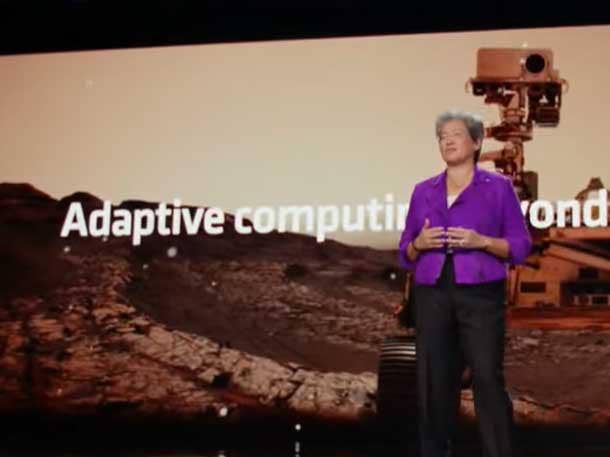
Adaptive Computing Will Provide Computing Flexibility
Adaptive computing will be a major force going forward, Su said, and AMD will be at the forefront with technology from its Xilinx acquisition, which gave AMD leadership in a whole new set of technologies and a whole new set of markets.
“Adaptive computing solutions are unique in that the hardware can be changed and optimized multiple times to perform whichever tasks you need,” she said. “And this allows a chip to be adopted for optimal performance for a specific application, or actually changed on the fly to add new features.”
AMD is No. 1 in adaptive computing, with 10 of the top auto manufacturers, six of the top seven 5G wireless equipment manufacturers and over 6,000 different health-care, aerospace, industrial and other embedded product businesses as customers, she said.
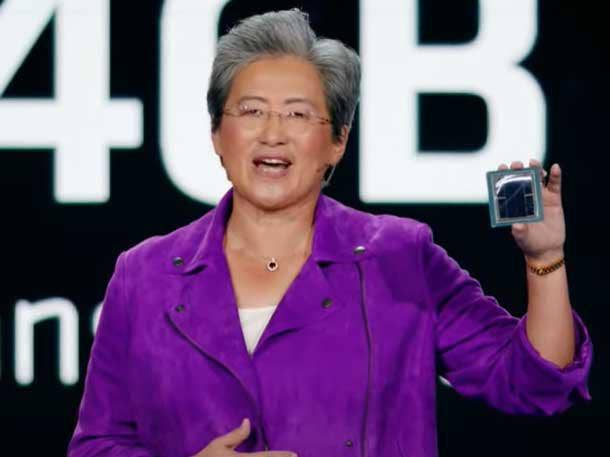
Sustainable Computing Will Impact Data Centers
AMD has a history of pushing the envelope in meeting the insatiable demand for more data center compute in the most sustainable fashion, Su said.
AMD in November launched its fourth-generation EPYC processor with up to 96 Zen 4 cores and support for next-generation memory and I/O, along with leading energy efficiency, Su said. It also features up to three times the performance and 2.6 times the energy efficiency of competitors’ highest-end processors in cloud, enterprise and high-performance computing applications, she said.
“This is really critical as data center power consumption becomes a larger portion of the world’s energy usage and IT departments manage higher energy costs and constrained energy supply. … A typical rack in a data center can hold up to 15 servers. If you choose our competition’s servers, 15 servers would deliver 8500 SPECint_rate performance. You can achieve that same level of performance with just five AMD fourth-gen EPYC servers,” she said.
Given that about 15 million AMD-based servers were deployed worldwide in 2022, that means with EPYC, data centers saved 52 billion kilowatt-hours of electricity and avoided 26 million tons of CO2 emissions, Su said.
“To remove this much CO2 from our atmosphere would require 28 million acres of forest,” she said. “That‘s actually more than all of the national forest land in the state of California.”
To improve AI’s ability to use inference to turn data into insight and actions, AMD previewed its first inference accelerator, the AMD Alveo V70, built with AMD XDNA technology, which Su said is the same AI engine processor used with Ryzen AI.
“But it’s scaled up for use in servers to deliver 400 trillion AI operations per second,” she said. “We designed Alveo V70 to accelerate multiple AI models, including video analytics [and] customer recommendation engines, while delivering just great compute efficiency in a small form factor.”
AMD is taking preorders for the Alveo V70, with delivery expected this spring, she said.
To meet next-generation high-performance computing and AI requirements, AMD introduced the AMD Instinct MI300 data center processor, which Su called the first chip that brings together a data center CPU, GPU and memory into a single integrated design for easy sharing of system memory and I/O resources.
“It results in a significant increase in performance and efficiency [and] it’s much easier to program,” she said. “MI300 combines our next-generation CDNA 3 GPU architecture that’s optimized for HPC and AI performance, as well as 24 Zen 4 cores. And to feed all those compute engines, we added 128 gigabytes of HBM3 memory.”
The Instinct MI300, with over 146 billion transistors, uses 3-D stacking to put multiple GPU and CPU chiplets on top of the base die, which connects the HBM3 memory to the rest of the system, Su said.
“This is actually the most complex chip we’ve ever built,” she said.
The MI300 can train much larger AI models faster at lower costs, and with less power, than other processors, Su said.
“There’s been a lot of talk about ChatGPT and what you can do with these large language models,” she said. “What you probably didn’t know is that it takes months to train on thousands of GPUs that consumed millions of dollars of electricity. MI300 can reduce the time to train these models from months to weeks, with dramatically lower energy costs. And more importantly, it can also support much, much larger models that can be used for even more advanced and more powerful AI services in the future.”
The AMD MI300 is currently in the labs and will be sampling to customers shortly. It is expected to come to market in the second half of the year for both high-performance computing and AI solutions, she said.